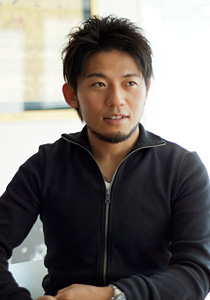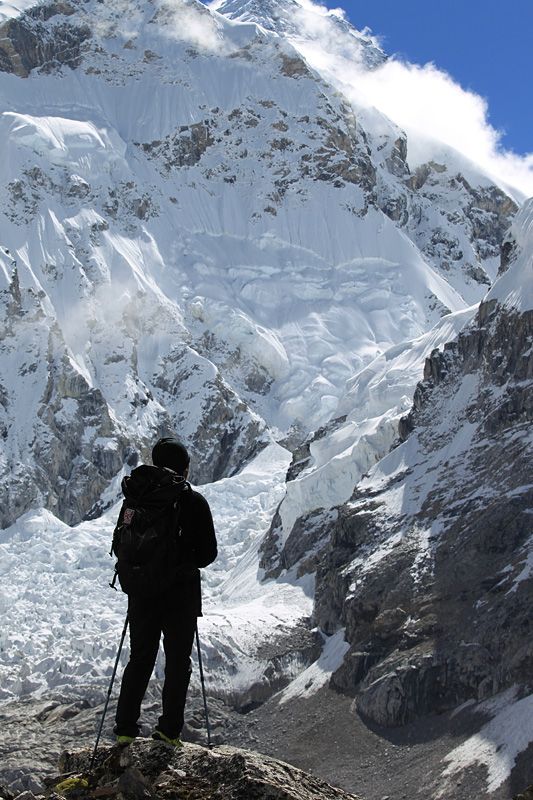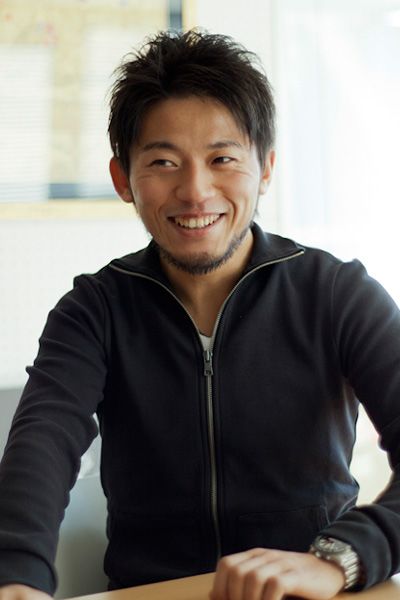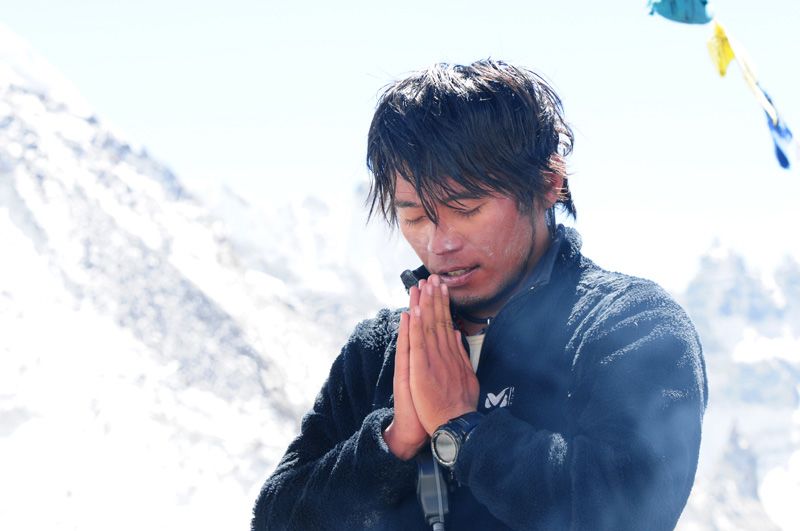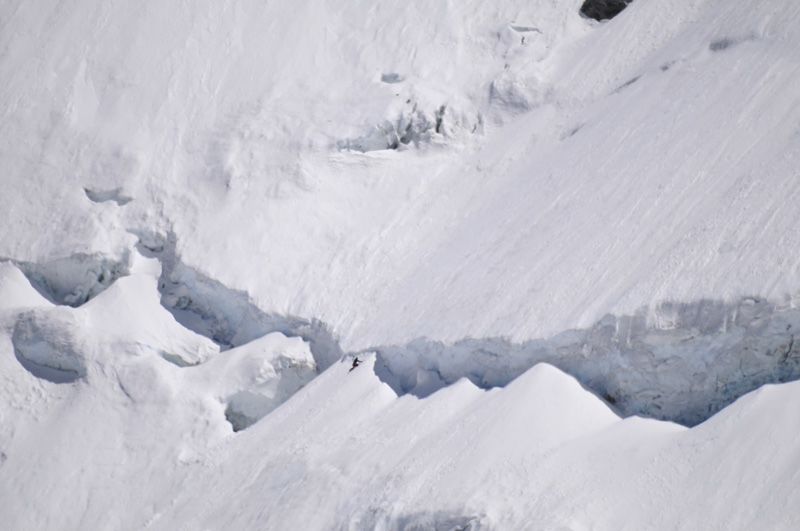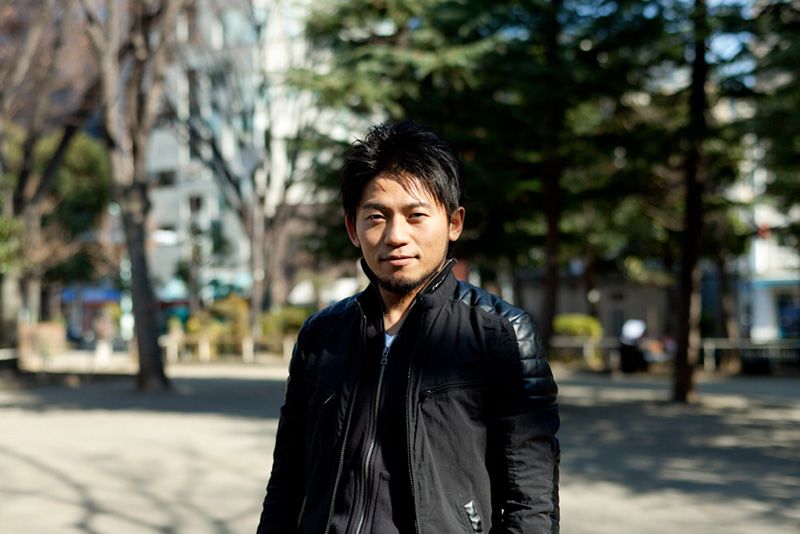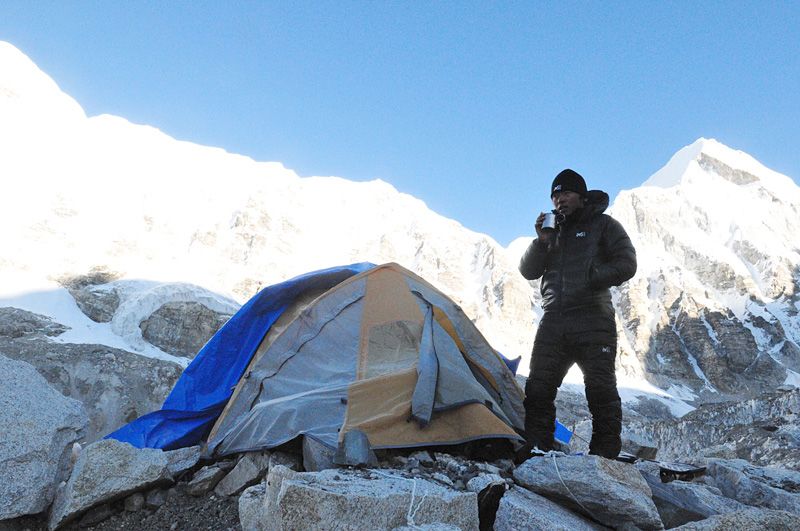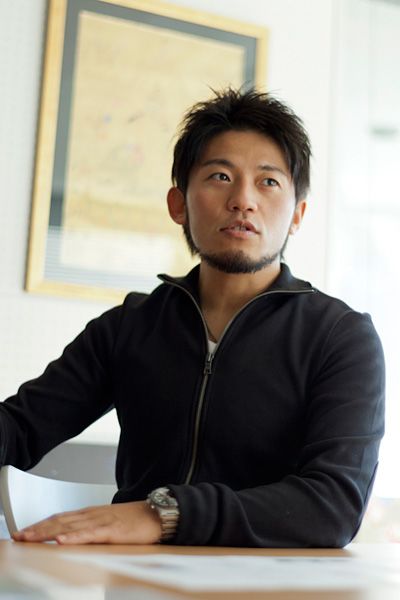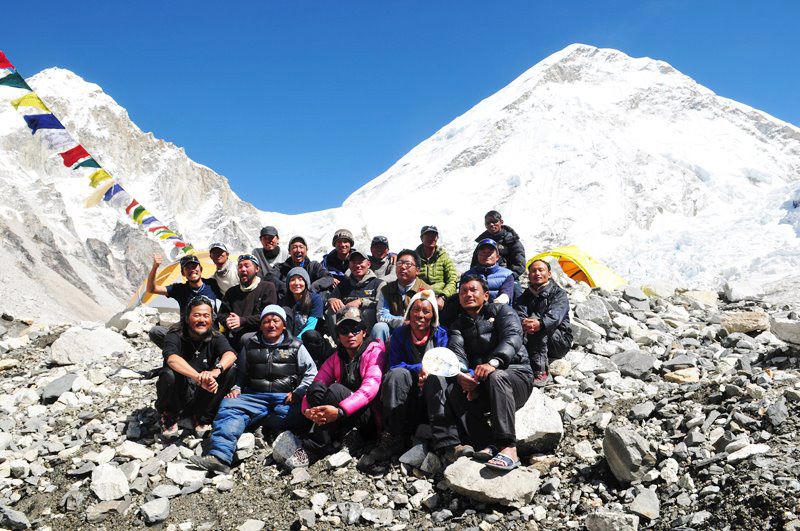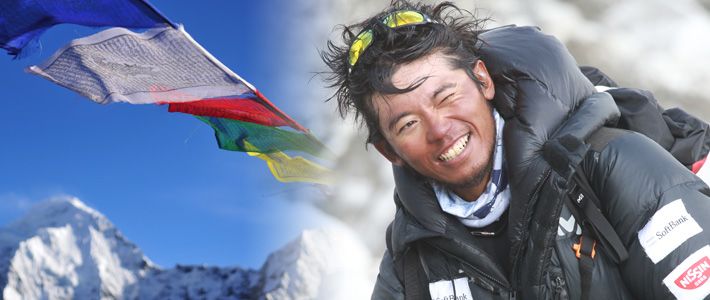
“Sharing My Adventures” With the World
Culture- English
- 日本語
- 简体字
- 繁體字
- Français
- Español
- العربية
- Русский
Real and “Invisible” Mountains
“Even after returning from the mountains to ordinary life, there are challenging peaks all around me in the course of city lives. I often feel that these ‘invisible’ mountains are even taller and steeper than the Himalayas,” says mountain climber Kuriki Nobukazu.
This ordinary-looking young man, just 162 centimeters tall and about 60 kilograms in weight, is attempting a live net broadcast of his solo climb of Mount Everest without supplemental oxygen. Kuriki represents a new breed of mountain climber, embracing the difficult method of climbing solo without relying on oxygen—and conveying real-time images of his adventures to viewers around the world, as he explains:
“I’ll be broadcasting live images of my Himalaya climb live over the Internet. This requires a lot of money to cover the cost of materials, transportation, and transmitting a massive amount of data via satellite. Raising those funds is another ‘invisible mountain of the city,’ even taller and steeper than the Himalayas. [Laughs] Practically every day I am giving talks to raise money, and using whatever other days are available to search for sponsors. This means that I am extremely busy, but I have no intention of giving up. If, for instance, a company is sympathetic to my project but can’t donate money, I will ask the company president to introduce me to friends who might make a donation. Friends of company presidents, I have found, tend to be quite wealth. [Laughs] That’s how hard I’m working to raise funds for my mountain climbing projects.”
Kuriki has been making the rounds to drum up donations ever since he was in his twenties. Usual he is just wearing a T-shirt and jeans, with a backpack slung over his shoulder, when he visits companies to win their sponsorship with tales of his future dreams. Year after year the list of companies and individuals backing him has grown.
Every autumn since 2009, Kuriki has attempted to climb Everest on his own, without carrying supplemental oxygen. This is a feat that is even more difficult than in spring, and so far he has had to abandon the climb each time on the brink of success, with the summit in view. But he is not giving up, remaining convinced that “limits are a fantasy we create ourselves.” Committed to his quest to conquer Everest in the autumn without oxygen, he continues to work steadfastly toward that goal.
Pursuing a Goal One Step at a Time
“In Japan today you can go into a convenience store 24 hours a day and buy a rice ball for just a hundred yen,” Kuriki observes, “so we can scarcely imagine starvation. But what I have seen in other countries, like Nepal, is that this enviable prosperity is far from common. That’s why I can’t just take it easy and stay in Japan. Of course I don’t think that there is anything bad about prosperity. But I do think that young people in Japan these days are scared of losing that prosperity and are just seeking stability. You need risk losing out on comfort and take a risk to pursue your dream.”
Speaking with a passion that belies his relaxed, smiling expression, Kuriki goes on to explain how his recent lecture tour of Japan has left a deep impression on him:
“One of the key themes of mountain climbing for me is to ‘share my adventure’ through video recordings or online live streaming. In this sense, it always feels like I’m climbing a mountain together with my supporters. And everybody is straining to climb their own invisible mountains in their busy urban lives, and sometimes hesitating before that challenge. I hope that when people see how I’m tackling Everest, they’ll get the courage to take the first step toward realizing their own dreams.”
Kuriki provides live updates on the progress of his climbs, using Ustream, Twitter, or Facebook, and also uploads videos to YouTube. Since he shoots most of the videos of his solo climbs himself, the result is quite different from elaborately filmed documentaries. His videos have gained a large viewership, not only in Japan but around the world.
“The first time I streamed a live video online was in 2007, for my climb of Cho Oyu. The footage was available via an online video site owned by Nippon Television Network Corporation, and was titled: ‘A NEET Alpinist’s First Himalayan Climb.’ [Laughs] While I was on the mountain, I was getting emails from NEETs and hikikomori [youth withdrawn from society], and a lot of them said negative things like: ‘There’s no way you can do it!’ or ‘I hope you fall off and die!’ After I reached the summit, though, the tone of the messages changed, and some of them were saying: ‘Thank you!’ Prior to that experience, climbing had always been a personal quest for me, but seeing how people had been moved by my efforts multiplied my joy many times over. Since then, ‘sharing adventure’ has become my motto.”
We Make Our Own Limits
As the title of that first live stream suggests, Kuriki was not the sort of person who was interested in mountain climbing from a young age.
“I first got into mountain climbing as a university student, because a girl I liked—who dumped me—was into it. [Laughs] Before university, when I moved from Hokkaidō to Tokyo, I sort of got off track; I was getting by on part-time work and not doing much—basically hiding in my house like a hikikomori. My girlfriend at the time told me she was only interested in marrying a university graduate with a government job and a car. So I headed back up to Hokkaidō to attend college. Eventually I saved up enough money from part-time jobs to buy a car and started studying intensely to pass the civil service exam. And then, after all that, my girlfriend dumped me! [Laughs] I still had feelings for her, and since she had been into mountain climbing, I decided to join the college climbing club. I was curious to find out what sort of sights she had seen on her climbs.”
That breakup led Kuriki to take the first step toward a new life and career, but it was not easy at first. Some of the upperclassmen in the club were quite severe with the newbies, and several times Kuriki considered calling it quits. But during a climb in Hokkaidō he had a sort of epiphany that changed his whole outlook. He recalls:
“It was a climb during the New Year holiday traversing the Nakayama Pass, from Sapporo to the Zenibako area of Otaru City. It took a whole week to make the trek across snow-covered mountains. At one point I thought I’d reached my limit and wanted give up. But somehow I powered through, and was rewarded with the most beautiful vista I had ever seen. I realized at that very moment that we make our own limits, and if we can just take one step beyond them we’ll find ourselves in a whole new world.”
Following that experience, Kuriki decided to attempt a solo climb of Mount McKinley, the tallest mountain in North America. But first he had to climb an invisible mountain, because his fellow club members were dead set against his plan, thinking it foolhardy for an inexperienced student to try such a thing.
“For me to go to climb Mount McKinley anyway would mean getting kicked out of the club and being shunned by that community of mountain climbers. There are no textbooks to follow when it comes to mountain climbing, so losing the chance to learn from the more experienced club members was a big problem.
“Still, I’m glad that I decided to climb Mount McKinley. If I hadn’t had that success, I wouldn’t be the person I am today. I should point out, though, that the club members who tried to stop me were just looking out for me. At the same time, though, there was nobody in the club who had tried a solo climb of Mount McKinley. That led me to think I’d never know unless I tried it myself.”
Based on that experience, Kuriki conveys to young people the message that you can only pursue a dream on your own, as he elaborates:
“There is a tendency in Japan today for schools to discourage students from pursuing a challenging goal, because the emphasis in the country is on stability. But the people who give you advice are not the same as you. They don’t share the same goals. They may not have the same experiences. So if you have a dream, you need to take the first step toward it yourself, without being scared of failure. My feeling is always that I’ll regret failure less than never trying at all. And in attempting to conquer Mount Everest on my own without oxygen I’ve had to turn back three times! [Laughs] The only person who’s ever successfully climbed Everest solo and without supplemental oxygen was Reinhold Messner, back in 1980. And no one has managed that feat when climbing the mountain’s southwest face. So I know that the task I’ve chosen for myself is not easy. But I’ll keep working toward that dream, no matter how many times I fail. It is important to keep on trying, even if you might not succeed.”
Sharing Adventure with the World
Kuriki says he has recently noticed a big change in the reaction he gets on social networking sites.
“The comments I used to get online or in person after giving a talk were mostly things like ‘Good luck!’ or ‘I’m rooting for you!’ But recently I’m hearing more specific, positive comments, like ‘You inspired me to work toward earning a certification’ or ‘I’m training to run a full marathon.’ It thrills me that my ‘sharing adventure’ message is gradually getting out there in the world.”
But there is also a downside to this interaction via social networks, and sometimes Kuriki gets negative comments. “Since people can send messages on a whim, you have to get used to critical or slanderous comments. Of course I sometimes fail, so my not-so-cool—or even incompetent—aspects are on display. But I think that revealing this is one element of my idea of ‘sharing adventure.’ Of course I do still feel pretty bad when people say bad things about me,” he laughs.
Seeing the True Face of Mountain Climbing
Watching live footage of Kuriki on one of his climbs reveals that he does not match the stereotype people have of “stoic” mountain climbers. Far from restrained, he will let out a yell upon reaching a summit, or moan when in pain, or even shed bitter tears. And when he talks about what’s on the menu for lunch or dinner he often looks as happy a three-year-old. All of these moods he experiences are on display in real time, via the Internet, allowing viewers to see what mountain climbing is really about.
“From the ground you can’t see what mountain climbing really involves, so there is a mystery that surrounds it. An interview with a famous mountain climber might convey their suffering or failures, but usually everything gets prettified for the story told in books or on television, and the other parts are edited out. I think this is how mountain climbers are deified as stoic characters. Some of the fans of those mountain climbers might look at what I’m doing and think, ‘That joker Kuriki is making mountain climbers look bad.’ But I want to give people a better idea of what the challenge of climbing involves, so they’ll feel a closer affinity for the sport.”
Thanks to Kuriki’s online presence he is becoming better recognized around the world, not just in Japan. Already in 2012, he has traveled overseas to give talks in Shanghai and Beijing, as well as South Korea, Taiwan, London, and New York. His enthusiastic fan base includes some celebrities, too, like the English electronic music duo Underworld, who will serve as the musical directors for the opening ceremony of the London Olympics.
“Mountain climbing, much like sports such as soccer, has a universal quality that bridges the language gap. The natural beauty of a mountain scene or the charms and dangers of climbing a tall peak are things that anyone can understand and appreciate. In fact, some of the most positive feedback I get these days comes from people in China, where the economy has been booming. When I emphasize the importance of challenging yourself, they seem to understand my message even better than people in Japan. This kind of reaction encourages me to keep on spreading my message of ‘sharing adventure’ around the world.
“My challenge for the spring of 2012 is to reach the summit of Shishapangma (8,027 m), called the ‘mountain of death.’ And in the autumn I’ll make my fourth attempt at Mount Everest. Knowing that I have supporters around the world keeping an eye on my activities is just the fuel I need to succeed in my adventures.”
(Translated from a January 17, 2012, interview in Japanese. Interview photos by Igarashi Kazuharu.)